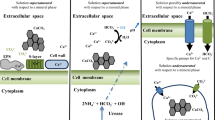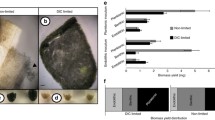Abstract
This paper reviews the general mechanismsof microbial carbonate precipitation and offersan alternative view on the role of calciummetabolism in this process, as well as on theoccurrence of species- and environment-specificcalcification.
Similar content being viewed by others
References
Boquet E, Boronat A & Ramos-Cormenzana A (1973) Production of calcite (calcium carbonate) crystals by soil bacteria is a general phenomenon. Nature (Lond.) 246: 527-529
Castanier S, Le Métayer-Levrel G & Perthuisot JP (1999) Cacarbonates precipitation and limestone genesis-the microbiologist point of view. Sediment. Geol. 126(1-4): 9-23
Desrosiers MG, Gately LJ, Gambel AM & Menick DR (1996) Purification and characterisation of the Ca2+-ATPase of Flavobacterium odoratum. J. Biol. Chem. 271(7): 3945-3951
Douglas S & Beveridge TJ (1998) Mineral formation by bacteria in natural microbial communities. FEMS Microbiol. Ecol. 26(2): 79-88
Erlich HL (1998) Geomicrobiology: Its significance for geology. Earth Sci. Rev. 45: 45-60
Ferrer RM, Quevedo-Sarmiento J, Rivadeneyra MA, Bejar V, Delgado R & Ramos-Cormenzana A (1988) Calcium carbonate precipitation by two groups of moderately halophilic microorganisms at different temperatures and salt concentrations. Curr. Microbiol. 17: 221-227
Fujita Y, Ferris EG, Lawson RD, Colwell FS & Smith RW (2000) Calcium carbonate precipitation by ureolytic subsurface bacteria. Geomicrobiol. J. 17(4): 305-318
Herbaud M-L, Guiseppi A, Denizot F, Haiech J & Kilhoffer MC (1998) Calcium signalling in Bacillus subtillis. Biochim. Biophys. Acta-Mol. Cell. Res. 1448(2): 212-226
Holland IB, Jones HE, Cambell AK & Jacq A (1999) An assessment of the role of intracellular free Ca2+ in E. coli. Biochimie 81: 901-907
Kaufman EN, Little MH & Selvaraj PJ (1996) Recycling of FGD gypsum to calcium carbonate and elemental sulphur using mixed sulphate-reducing bacteria with sewage digest as carbon source. J. Chem. Technol. Biotechnol. 66(4): 365-374
Kile DE, Eberl DD, Hoch AR & Reddy MM (2000) An assessment of calcite crystal growth mechanisms based on crystal size distributions. Geochim. Cosmochim. Acta 64(17): 2937-2950
Kramer G, Klingler HC & Steiner GE (2000) Role of bacteria in the development of kidney stones. Curr. Opin. Urol. 10(1): 35-38
McConnaughey TA & Whelan FF (1997) Calcification generates protons for nutrient an bicarbonate uptake. Earth Sci. Rev. 42: 95-117
McKay DS, Gibson EK Jr, Thomas-Keprta KL, Vali H, Romanek CS, Clemett SJ, Chillier XD, Maechling CR & Zare RN (1996) Search for past life on Mars: Possible relic biogenic activity in Martian meteorite ALH84001. Science 273: 924-930
Morita RY (1980) Calcite precipitation by marine bacteria. Geomicrobiol. J. 2: 63-82
Norris V, Grant S, Freestone P, Canvin J, Sheikh FN, Toth I, Trinei M, Modha K & Norman N (1996) Calcium signalling in bacteria. J. Bacteriol. 178(13): 3677-3682
Peckman J, Paul J & Thiel V (1999) Bacterially mediated formation of diagenetic aragonite and native sulphur in Zechstein carbonates (Upper Permian, Central Germany). Sediment. Geol. 126(1-4): 205-222
Rivadeneyra MA, Delgado R, Del Moral A, Ferrer RM & Ramos-Cormenzana A (1994) Precipitation of calcium carbonate by Vibrio spp. from an inland saltern. FEMS Microbiol. Ecol. 13: 197-204
Schultze-Lam S, Fortin D, Davis BS & Beveridge TJ (1996) Mineralisation of bacterial surfaces. Chem. Geol. 132: 171-181
Stocks-Fisher S, Galinat JK & Bang SS (1999) Microbiological precipitation of CaCO3. Soil Biol. Biochem. 31: 1563-1571
Warthmann R, van Lith Y, Vasconcelos C, McKenzie JA & Karpoff AM (2000) Bacterial induced dolomite precipitation in anoxic culture experiments. Geol. 28(12): 1091-1094
Wright DT (1999) The role of sulphate-reducing bacteria and cyanobacteria in dolomite formation in distal ephemeral lakes of the Coorong region, South Australia. Sediment. Geol. 126(1-4): 147-157
Vali H., McKee MD, Çiftçioglu N, Sears K, Plows F, Chevet E, Ghiabi P, Plavsic M, Kajander O & Zare R (2001) Nanoforms: A new type of protein-associated mineralization. Geochim. Cosmochim. Acta 65(1): 63-74
Yates KK & Robbins LL (1999) Radioisotope tracer studies of inorganic carbon and Ca in microbiologically derived CaCO3. Geochim. Cosmochim. Acta 63(1): 129-136
Author information
Authors and Affiliations
Corresponding author
Rights and permissions
About this article
Cite this article
Hammes, F., Verstraete*, W. Key roles of pH and calcium metabolism in microbial carbonate precipitation. Re/Views in Environmental Science and Bio/Technology 1, 3–7 (2002). https://doi.org/10.1023/A:1015135629155
Issue Date:
DOI: https://doi.org/10.1023/A:1015135629155




